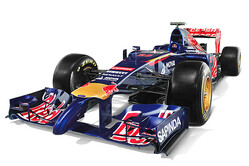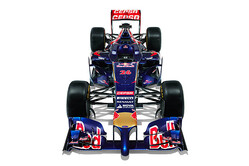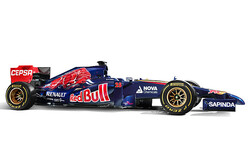


27/01/2014
NEWS STORY
 The Englishman, who joined the Faenza squad from Sauber in late 2012, has spent much of his time since then concentrating on the STR9, mainly because the team's 2013 contender was already well underway by the time he arrived but also because of the enormity of the 2014 rule changes.
The Englishman, who joined the Faenza squad from Sauber in late 2012, has spent much of his time since then concentrating on the STR9, mainly because the team's 2013 contender was already well underway by the time he arrived but also because of the enormity of the 2014 rule changes.
"The aero side was by far our biggest priority, as we wanted to put that department into a much more current and competitive shape," he says. "Over the past twelve months, we've been working on increasing the size of the aerodynamics department. It's grown significantly, and we now have many new people with very relevant F1 experience. We have more people joining us this year too, so I would describe it as a work in progress, but the group is developing very well and becoming increasingly close to the blueprint that we have in mind of what an aero department of a team of this size and budget needs to be.
"We're still getting there but it's certainly heading in the right direction. It's been a big project, helped by the arrival of a new head of Aerodynamics in Bicester, Brendan Gilhome last June, while we worked on 2014 without neglecting the task of making the most of the 2013 car as well. It's still going on but it's developing very much in the direction it needs to be right now and we're making good progress."
The switch to a 1.6 litre turbo engine for next year has been the biggest talking point when it comes to this year's major rule change and at Toro Rosso, this has also involved a change of partner, with Renault supplying what is now referred to as the power unit (PU), primarily due to the significant mix of IC engine and Energy Recovery Systems.
"Changing your engine partner is always a bit of a step into the unknown for both parties, until that working relationship is established and everyone understands how best to operate together," says Key. The agreement with Renault was announced at last year's Monaco Grand Prix and work begun immediately to ensure things would go smoothly this year.
 "Renault were very supportive from the outset, making sure we had a very good overview of what they've been up to with the PU and their plans for development, so we were able to get up to speed very quickly with it," maintains Key. "To switch from a process where you've got a well-established and understood way of working with the previous engine supplier to a situation where you have not only a new engine supplier but also a totally different type of power unit that we're not familiar with at all, is quite a big leap. Not only are you trying to establish the relationship, you're doing it through what is a very complex project for both sides. I have to say, Renault has been excellent at recognising that and helping us out a great deal. They are very proactive and we have daily discussions between our design team and theirs. We have already built up a good working relationship with them."
"Renault were very supportive from the outset, making sure we had a very good overview of what they've been up to with the PU and their plans for development, so we were able to get up to speed very quickly with it," maintains Key. "To switch from a process where you've got a well-established and understood way of working with the previous engine supplier to a situation where you have not only a new engine supplier but also a totally different type of power unit that we're not familiar with at all, is quite a big leap. Not only are you trying to establish the relationship, you're doing it through what is a very complex project for both sides. I have to say, Renault has been excellent at recognising that and helping us out a great deal. They are very proactive and we have daily discussions between our design team and theirs. We have already built up a good working relationship with them."
One of the most commonly held myths in the F1 paddock is that Scuderia Toro Rosso is just a satellite team to Red Bull Racing, an incorrect assumption that dates back to the first couple of years of the team's existence, when the rules were different. Today, with the exception of very few components, such as the gearbox internals and the engine, the cars are entirely designed and manufactured in-house. This year's switch to Renault power, as used by Red Bull, means that once again, the two teams can enjoy some technical synergies.
 "It makes sense, given that fundamentally we are under the same ownership, to have the same power unit as Red Bull, particularly with the arrival of such a complicated new set of regulations," admits Key. "Immediately, there's a synergy there because we are using the same power unit, we've been able to join with Red Bull Technology in using their gearbox internals. They have a well-engineered solution to 2014 regulations for these components, so again, it makes sense for us to join with them in using those common internals while running the same power train. Otherwise, obviously, the rest of the car is entirely an STR design."
"It makes sense, given that fundamentally we are under the same ownership, to have the same power unit as Red Bull, particularly with the arrival of such a complicated new set of regulations," admits Key. "Immediately, there's a synergy there because we are using the same power unit, we've been able to join with Red Bull Technology in using their gearbox internals. They have a well-engineered solution to 2014 regulations for these components, so again, it makes sense for us to join with them in using those common internals while running the same power train. Otherwise, obviously, the rest of the car is entirely an STR design."
The new type of Power Unit has inevitably had an effect on other areas of the STR9 design. "The installation of the PU is in itself a big challenge, dealing with the cooling circuits and other related elements, but the chassis and bodywork regulations have gone through quite a big change as well and the cars look quite different this year in some areas. So a big part of the chassis development has involved redeveloping the aerodynamic philosophies in line with the new regulations and getting them to work with all the other challenges that come along for 2014. Although certain areas of the car will not look particularly different the subtle changes with the 2014 bodywork regulations have had a surprisingly big effect, so we have had to re-evaluate some significant areas of the cars aerodynamics"
Apart from the specific tasks aimed at being ready for action in Melbourne in mid-March, work continues on improving the infrastructure and facilities and working practices in the Faenza factory.
"As far as the team is concerned, the summary is it's a work in progress," concludes Key. "We were quicker than the points scored suggested in 2013, if you could look behind the numbers, but we didn't make the most of our opportunities. Therefore, we're putting all our efforts into ensuring we have a better situation for this year."